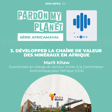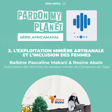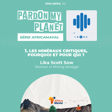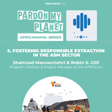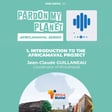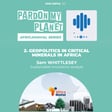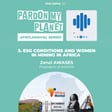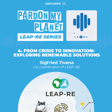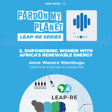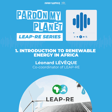Become a Creator today!Start creating today - Share your story with the world!
Start for free
00:00:00
00:00:01

How to finance CRM projects in Africa
This last episode of the AfricaMaVal series illustrate the tangible impact AfricaMaVal can have through the selection of 100 project opportunities.
Transcript
Introduction to Sustainable Mining
00:00:11
Speaker
Hello and welcome to Pardon My Planet podcast. I'm Anne-Charlotte, your host. This is the third episode dedicated to sustainable partnerships in mining between Africa and Europe.
Geopolitical and ESG Challenges in African Mining
00:00:23
Speaker
If you haven't heard listened to the previous episodes, I strongly recommend you to go and listen to them on the LGI website, lgi.earth.
00:00:32
Speaker
We have talked about the critical raw materials, the geopolitical challenges and the environmental, social and governance conditions in mining in Africa.
Financing Sustainable Mining Projects
00:00:43
Speaker
Today, we talk about financing. In this series, we have a chat with experts from Africa Maval. It's a collaborative project between Africa and Europe on securing the raw materials value chain between Europe and Africa and above all, make it sustainable.
00:01:02
Speaker
Africa-Maval analyzes projects, it aims to shortlist about 100 of them, considered as a responsible investment opportunity.
Mining Value Chain and Project Development
00:01:12
Speaker
The crucial aspect for these projects will be to find financing so they can actually launch. We welcome today Andor Olyps, he is a senior advisor at HCF, an independent corporate finance advisory company,
00:01:28
Speaker
He is leading the work on identifying financial instruments and provide strategic and financial advices across the complete life cycle of a project. Hello, Endor. Good afternoon, Angelou. Good afternoon. The projects ah so that are about to be selected are not just about mining in general. They are at different stages of the value chain. ah Can you first describe the different steps or stages we find in this value chain in mining?
00:01:58
Speaker
Yes, of course, Angelot, happy to do so. And maybe familiar to some of your listeners, we if we would break up the value chain for a mined product, so a mineral or a metal eventually, um and we can say, okay, let's start. Step one of the value chain is an exploration phase. It is the phase where we will try to locate and identify resources of these minerals and metals in their geological framework. So that's the first step of exploration. Then once we have identified um any ah viable or potentially viable resource then we can consider let's say the next phase or the value chain which is eventually the mine building and bringing this mine to production so that we can extract these resources of metals and minerals. Maybe
00:02:54
Speaker
Before I carry on along the value train of a value chain, the intermediate step maybe between exploration and mine building is obviously quite an extensive time of project development where we will simply and trying to understand what the project is about, how we want to construct it, what are the risks that surround that project and how we can maybe red reduce those risk levels or even mitigate those risks so that we can build that project successfully. It must be a quite a long time, right, to do that? It is quite a long time and that's why I would like to highlight it because in some way you can say, well, maybe this is not directly part of the value chain. Step one, identifying the resources. Step two, extracting the resources. All sounds very clear, but in between and that is a very important phase to consider
00:03:48
Speaker
is that ah project development helping to increase our confidence level on how the project would look like and also the confidence level or how relevant and how economically relevant this project can be because that is important for our next considerations and you already mentioned that in your introduction if we're going to talk about ah responsible investment opportunities then we have to understand how mature are these opportunities? But that is for later in our ah discussion. So back to the value chain.
Critical Raw Materials for Modern Needs
00:04:23
Speaker
Exploration, step one, mining, mine building and production, step two. And then basically step three, a phase, quite a long line along the value chain of processing, refining, could also include transport of the material across um ah several locations.
00:04:44
Speaker
or other value add processing to basically build or create a half product or an end product that is of interest to the end user markets. And you have the vendor recycling part as well? Yes. So in some way, per se, ah the value chain of primary sourcing of metals and materials and starts with that geological framework, the geological context into the production. But yes, indeed, very important. to include any opportunity to recycle um existing resources from previous use to future use. In some way, you can say the more we are able to recycle, the less we are obliged to extract from a primary ah source.
00:05:33
Speaker
So to provide concrete examples about these 100 projects that are about to be selected, what types of projects are we talking about and where do they stand in this ah value chain ah in mining? Maybe ah first, what is very ah special about the current time in the world, in the market, the way we are looking at critical raw materials,
00:06:02
Speaker
um it also means that we're looking at a group of rather new gold and new metals or minerals or at least metals and minerals for new purposes. At the end, the critical raw materials exist because we would like to support the energy transition moving away from let's say our fossil fuel use to alternative energies and we want to support our digital transition and basically supporting our role into the digital ah era. That requires certain um components, that requires certain elements, certain technologies, and for that we use these so-called critical raw materials. So we are also looking at a set of minerals and metals that we have not been looked at that have not been looked at in the past.
00:07:02
Speaker
simply because there was not so much of an economic interest to them. So they are not new, right? they they They have been discovered before, but not used. Is that what you mean? Exactly. They have always been part of the geological framework. ah Maybe they already have been identified by previous geological or geological survey campaigns. Maybe they even exist on the geological maps of the different countries. But let's say where ah we have been or Mankind has, for instance, been looking for gold and mining gold for thousands of years. Well, we have not been looking for, call it rare earth elements or graphite or cobalt for thousands of years. Their relevance is today.
Understanding Project Viability in Mining
00:07:51
Speaker
And so we are in some way relying on pre-existing knowledge as to your point in our, let's say,
00:07:58
Speaker
um geological memory or the geological data repository so that we can build on that knowledge and look for these metals and minerals ah in in the context of today. So that means, back to your question, where what are the the primary projects of focus are primarily the projects that sit partly developed or maybe still undeveloped in their geological context.
00:08:27
Speaker
And that they they are waiting for some way for so for recognition, um for demonstrating the economic viability of these projects and bringing these projects into production. So it's ah pretty much the, let's say they have done the exploratory parts, but they are still, let's say to build the mine at at the place. Is that what you mean? Or is it um just proving the value along the whole value chain of this particular mineral?
00:08:55
Speaker
the ah The value of the whole value chain is becoming more and more relevant. and So this is not just about looking at a deposit and understanding if I can mine it. No, this is about looking at a deposit and understanding how the material that comes out of this deposit basically services an entire value chain until the end product. And it is that consideration that's may also causing for additional time required.
00:09:24
Speaker
to understand if it is this particular deposit and not its neighbor or a third de deposit that is maybe more relevant. But it is also indeed to start placing this deposit in the technological and economic but context of today. The material maybe have been identified and indeed it may have been already sitting on a geological map identified decades ago, but understanding in the techno-economic context of today, what that material could contribute to our value chain requires additional studies.
Funding Sources and Investment Strategies
00:10:05
Speaker
And these studies are necessary before we would enter into say the most finance-demanding phase of the value chain, which is the construction of that mine, which is ah requiring a lot of capital, but you only want to spend that money if you are sure that this project is viable.
00:10:28
Speaker
So this project, as you say, are ah very let's say money consuming because you have all this building phase and all at this ah phase of exploratory parts, if it's viable or not. Once we say that, what are the sources of funding that we can look ah on? Is it ah public funding? Is it private funding? How does this all work? Well, that's a very interesting question.
00:10:57
Speaker
and I may give you a long winded answer here, but let maybe let's just ah break that up a little bit and say, okay, we are looking for capital support. who We're looking for money for funding in support of that project development. Now, first, as I mentioned before, the construction of a mine is a very capital intensive um project. ah Mines are built today.
00:11:24
Speaker
against a cost of several hundreds of millions of dollars or euros or even more. So a billion euro mine construction is not an exception anymore. So these are significant numbers. So where is that money coming from? Maybe that money is coming in partly in part from the balance sheet of the project owner.
00:11:50
Speaker
Maybe a mining company may have capital available and prioritized ah to spend on the construction of a new mine. But in addition, it may look for additional funding and that funding could come from investors.
00:12:09
Speaker
and that can be by So investment means um sharing some of your ownership. That is how basically you're selling shares or you're attracting capital in exchange for a little piece of ownership in your company. And so that attracts a certain group of financiers that maybe may have interest um in that ah investment. We can also say, for example, well, maybe maybe just maybe their primary interest is just in making money in. So in having yield, um I invest $100 in your company.
00:12:47
Speaker
And I hope that ah in the near term, I make more than $100 of primary investment and my investment is worth $150. And then ah that is but the benefit, the the yield, the return that this investor is looking for. That is on the investment side. And we can um discriminate between whether that investment is purely on making money, trying with people trying to put money at work to make more money in a way while supporting that industry. It can also be related to strategic investors, ah companies, even countries that have a preferred interest in that ownership that basically would like to have a piece of the pie under their ownership. And so they may buy in for several will per percent in that ah either the holding company or the project company that is developing that mind.
00:13:47
Speaker
So we're still and at that mine development. Let's say we're still building our 1 billion euro mine. Then there is another a piece where money could be derived from, and that is the debt side. So we talked about equity and the other side is debt. So we are borrowing money. And it's the same as when you would go to the bank. Indeed, when you're buying a car or buying a house, you don't have that money available yourself.
00:14:16
Speaker
but you are investigating if the bank is prepared to support you in that, is if the bank is prepared to lend you money. Can you go to the bank and ask for opening a mine project? Maybe not so directly, but in some way you can. And there are banks that are also commercial banks that we know from our day-to-day work um at the moment, ah primarily banks, active ah predominantly in Europe or with European roots. I know ah by experience ING Bank in the Netherlands or Société General in France and so many other banks that could um basically provide capital under a loan arrangement. So then you have to make almost a contractual arrangement that basically stipulates how
00:15:13
Speaker
and under what condition the bank is providing you with the money but also under in what way you're going to repay that money and how much interest for instance you will be repaying over the money that you have borrowed.
Risk Management in Mining Investments
00:15:30
Speaker
and But ah borrowing money from a bank um includes still a certain and risk level. added the The transaction is not free of risk.
00:15:42
Speaker
That doesn't mean that it is a very risky business and it's also what the audience should should understand, but you still want to have such an arrangement that if something goes wrong, that at least the bun the bank feels comfortable in providing that money and feels that the money they provide is protected by some way, eater by either having um a scheduled repayment that that shows you that as soon as your mine is in production, because that is the other thing, we are constructing something. Money is going in, money is going in the ground to build the mine and only when the mine is up and running, I am producing and I'm generating cash flow and I have an ability to repay my loan. But if something would go wrong in between, the Navy, the bank would step in
00:16:38
Speaker
and take security or claim security as per the agreement and it could for instance be the ownership of that half-built mine or the underperforming mine. And it's the same as when you would buy your house and you would get let's say a mortgage that in case you would not be able to repay the bank then at least the bank is comfortable that they can take ownership over your house in case you.
00:17:03
Speaker
So as you say, there are a hundred projects that are about to be shortlisted. They will be considered as responsible investment opportunity. This is also what you mean. It means to build credibility for those projects, for the investors. Yes, absolutely. um And um let me explain because so also that it it it is very easy and and not right to assume that, okay, as soon as you as a project is shortlisted, that money will be available.
00:17:32
Speaker
Well, that is simply not the case.
Communicating Project Potential to Investors
00:17:35
Speaker
um And also in the context, for instance, of Africa-Maval or in the context of HCF's work in Africa-Maval, it is not that once we highlight a project or once we list a project in that list of 100, that automatically ah money will be there. So it is... um I would say we can use the shortlist of responsible investment opportunities or shortlist of responsible potential investment opportunities also as a communication vector so that we show potential financiers what we have or what Africa has an offer in that respect, but also to show the project owners what could be required to really attract that capital.
00:18:26
Speaker
So it is basically stimulating the dialogue between potential financiers and project owners, because we know by experience what financiers would require, what they are looking for even before they have interest in a project. And at the same time, we know that financiers are very experienced. They do their homework very well.
00:18:52
Speaker
So you can also say that it would almost be a surprise if there is a project on that list that has not come to their attention before. But maybe by putting it on the list, we can provide additional information or direct access to that information that may not be available in the public domain or that at least allows the financier Yeah, to reconsider whether they have, let's say, appetite, whether they are attracted to that project, to finance. At the same time, the project owner should understand where their project is, again, in that yeah on that maturity curve, whether their project is ready for financing.
00:19:36
Speaker
so you Do you provide like advices ah if you ah think that there are not maybe enough proof that ah the project will be viable in the future? Absolutely. On one side, you can say every project is unique and every project will require a specific setup and therefore also if it comes to financing, it will have a very customized agreement between financier and project owner, but at the same time, we know by experience what financiers are expecting. So we can help the project owner to prepare for that. And at the same time, we can help the financier to either introduce them to what is coming or also helping them to understand why a project has maybe certain risk mitigants, why a project is
00:20:33
Speaker
viable for their type of financing. And on the other part, since it's supposed to be a win-win situation, let's say, and it's ah about being sustainable and being fair for everyone, do you also look into, let's say, the origins of the investments and the type of investments that are being made? Absolutely.
00:20:58
Speaker
Absolutely, and that is i already in Europe we are front running on applying ah the highest environmental and social and governance standards as available. Banks ah also have a set of standards, most most financial institutions, so that includes commercial banks, but also development financial institutions that are, let's say, state-related or others, work along a set of standards that basically promotes the highest level or the most positive levels of environmental standards, social standards and government standards governance standards.
Trends in Investment Strategies
00:21:44
Speaker
Which means that transparency in what you are doing and also to your question where money is coming from or how money is being used is part of that.
00:21:55
Speaker
And also maybe are there new emerging trends in investment or types of investment that we have not seen before? And in this type of project, it has an opportunity also to be made. Absolutely. um that and There are several trends in terms of financing. um that is One is because there is such a political push behind critical raw materials.
00:22:24
Speaker
And that is on different continents um and especially ah coming from the developed countries. And so the EU, but also individual European countries, have critical raw material strategies. The US, Canada, Australia, Korea, Japan, Saudi Arabia, they all show a specific critical raw material strategy. And in that strategy is also included certain ways or means to support the critical raw material value change financially either by tax credits or by providing funding or by tax rebates or whatever. So that means that because this exists that certain financiers are encouraged to ah approach the critical raw material value change.
00:23:24
Speaker
um We see that with um the DFIs, the Development Financial Institutions, so that are often financial institutions that are state-related, that provide can provide capital to pro promote the arrival of critical raw material production into their country. And it can be, we see, for instance, in Germany, the DFI is called KFW,
00:23:51
Speaker
and they provide quite significant capital for the development of certain projects outside of Germany, but with the ultimate aim to see some sort of benefit arriving into Germany. We see at the same time ah managed by Jüler Hermes, also in Germany, the Export Credit Agency providing a guarantee over a loan when ah material that comes from outbound or foreign production is arriving into the German industry. And so there are several but say financial instruments that are mobilized and encouraged to be mobilized um to support the development of the critical raw material value chain.
00:24:45
Speaker
So um does this mean also that the ah almost the end user is ah can participate in that investment? That is on top of that indeed. i we We mentioned earlier in our conversation that with the critical raw material value chain, we are stepping away from that traditional view that a mine site produces material and is selling that to the market.
00:25:12
Speaker
And that's maybe where it stops. And then the market is basically taking that material, but could also be taking similar material from other sources and is taking that further towards half product and final product. What we see now is that entities, companies are arriving in the market that are very much related to the final stages, and to the back end of that value chain. So very much downstream.
00:25:41
Speaker
but day one they are also concerned by security of supply. And maybe they can bring capital so that their future supply of critical raw materials or critical raw material components is secured. So that are the OEMs. And OEM stands for original equipment manufacturer. Not so important, but OEMs can be car manufacturers ah heavy equipment manufacturers. So let's say the um Tesla's of this world or the Mercedes Benz's or the Peugeot's can basically consider securing components of their future cars by um maybe investing or providing capital to these early stage projects. Okay. And make sure that they develop correctly so they are sustainable on a long period of time.
00:26:40
Speaker
Exactly, because they also for them reputation is key, so they want yes they want to secure their supply and at the same time they want to make sure that that security of supply is happening in a sustainable and I would say corporate corporately acceptable way.
Africa-Maval's Role as a Facilitator
00:27:00
Speaker
Absolutely. and Now, let's say a project is selected as a responsible investment opportunity. What happens next? Does the support of Africa Maval stop there? Is the project mature enough or is there any idea to, ah let's say, further support those projects beyond this ah label? when When listening to this question, I would say in some way, Africa Maval also because Afrikamaval is a network of entities and a network of entities with all kinds of different expertise. And collectively, Afrikamaval can still behave um maybe a little bit as a as a broker of that arrangement. Again, ideally, if a financier ah would and would be if the radar of projects for a financier would be fully populated,
00:27:57
Speaker
and the financier would know about all the possible projects and their stage of development and would know why it would finance certain projects or not, then in some way our work is done. But the reality shows that that radar of project is not fully populated and that the it's more complicated and we have to continue communicating about these projects.
00:28:26
Speaker
We have to continue highlighting these projects, but as I said before, in two ways, both to the project owner, and let me also include the project owning host country, helping them to understand what is required to maybe successfully develop that project. And at the same time, identify certain financing parties, all with their different behavior, all with their different investment strategy or risk appetite or commercial strategy, and we have to bring them together. So I think the role of Afrikaans has certainly not ended, but we will continue basically to broker and highlight why certain projects on that shortlist of responsible investment opportunities are interesting to certain financing parties.
00:29:16
Speaker
Thank you very much, Endor, for this ah enlightening conversation. If you want more information on the subject or on Africa-Maval, it's all on lgi dot.earth-slash-podcast. Until next time, bye-bye.
